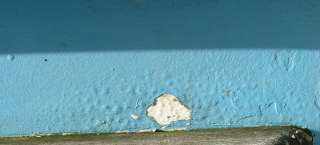 Deck Problems
Deck Problems Deck Problems
Deck Problems

The stanchion bases were crudely fixed to deck by Westerly :
Stanchions can be ripped out by minor collisions. Professional
repairs often are weaker than original. I would say you can tell if its
been repaired if it has no stress cracks in the deck around
the stanchion base.
For Forethought it looks like this : imagine this is counting from
bow to stern.
| Port |
Starboard |
|
| 1 |
No damage |
Professionally repaired with
about 30cm of deck gelcoat replaced |
| 2 |
Badly cracked round base and
down to hull-deck join at purchase, cracks opened out , cleaned and flooded with thickened epoxy, decking replaced. |
Minor cracks |
| 3 |
Ripped out in collision with RTI
declaration barge, ply plate under deck |
Ripped out by two different
neighbours in marina |
There will also be bolts visible below the deck if repaired, as Westerlys glassed over the underside of the bolts under the deck when they fitted the stanchions..
If the bases havent been ripped out the balsa core collapses and the stanchions become more vertical.
Fortunately, repairing the stanchion bases is a DIY possibility as there is access to the underside. I refitted one myself in 2 days of work.
Also look out leaks through deck fitting bolt holes causing water to get into the balsa deck core.
The hull itself is pretty solid - just the deck is a bit weaker ..As the deck bends under the stress of the rigging, eventually the chain plate lifts away from the deck, the sealant cracks away, and water goes down the bolt holes and inside.
Unfortunately I just found another leak that involves some 'rotten' brass screws. It doesnt sink the boat but it makes a mess.
The screws that fix the main hatch housing assembly to the coachroof become damp as the sealant under the teak fails. They are then rotted away and then snap off when it freezes after heavy rain (December 1999). Remaining screws are usually so rotten you can not undo them but they shear off nicely.
Further rain then runs down the screw holes and under the headliner to appear in the lockers above the berth. This results in saturated foam in the headliner.
Its DIY fixable but uses a lot of glue and drying out time with the headliner.
You have to remove the teak bar across the forward end of the hatch
on the coachroof first of all as this locks the other teak bars to port
and starboard.
Undo all the screws including the ones attaching the bars to the
upright surrounds for the washboards under teak plugs.
Move the forward ends of the bars in towards the centreline of the boat
to remove them.
There is a slot on the lower edge of these bars that engages with the
coachroof GRP.
I had re-seated some components with Sikaflex and the wood split rather
than the Sikaflex coming un-stuck. Watch out.